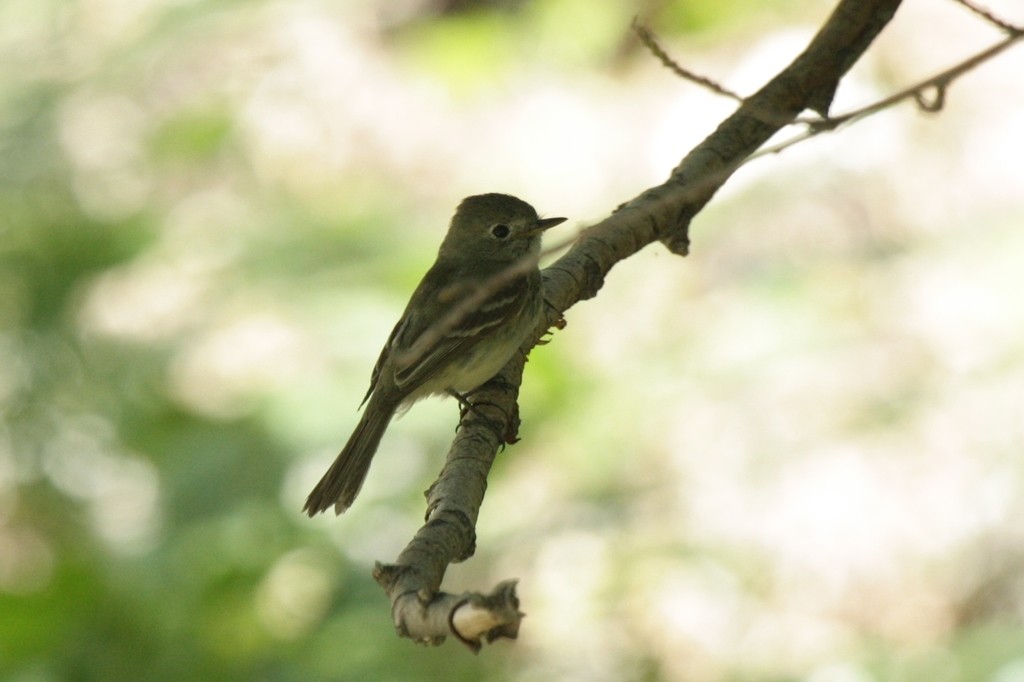Dusky Flycatcher
A species of Empidonax flycatchers Scientific name : Empidonax oberholseri Genus : Empidonax flycatchers
Dusky Flycatcher, A species of Empidonax flycatchers
Botanical name: Empidonax oberholseri
Genus: Empidonax flycatchers
Content
Description General Info
 Photo By silversea_starsong , used under CC-BY-NC-4.0 /Cropped and compressed from original
Photo By silversea_starsong , used under CC-BY-NC-4.0 /Cropped and compressed from original Description
Adults have olive-gray upperparts, darker on the wings and tail, with whitish underparts; they have a noticeable medium-width white eye ring, white wing bars and a medium length tail. The breast is washed with olive-gray. The bill is mainly dark. It is a bit smaller than the American grey flycatcher and a bit larger than the Hammond's flycatcher. 
Size
15 cm (5.75 in)
Life Expectancy
6-9 years
Nest Placement
Shrub
Clutch Size
2 - 5 eggs
Incubation Period
1 brood
Number of Broods
15 - 16 days
Nestling Period
15 - 20 days
Feeding Habits
Dusky Flycatcher predominantly feed on insects, catching them mid-flight or plucking from vegetation and the ground. They forage in lower arboreal zones and brush during breeding season, primarily consuming moths, butterflies, caterpillars, wasps, bees, grasshoppers, damselflies, bugs, flies, and beetles. They subdue their prey by whacking it against branches before eating.
Habitat
The dusky Flycatcher typically resides in western mountainous regions, favoring open, brushy environments. This bird thrives at altitudes hosting a mix of thickets, mountain chaparral, aspen groves, and shrubby stream corridors. Its habitat is characterized by interspersed trees and dense understory vegetation comprising willows, alders, pines, and oaks. Furthermore, the dusky Flycatcher adapts to disturbed settings with sufficient brush and tree coverage, and during migration, they favor brushy, tree-dominated areas.
Nest Behavior
The female dusky Flycatcher constructs the nest and lines it for comfort. Nesting activities commence in spring to summer with the precise timing varying with location. Dusky Flycatcher typically lays 3-4 eggs which are incubated by the female, while both parents are involved in feeding and protecting the young.
Nest Characteristics
Dusky Flycatcher's nest is built in a tree or shrub crotch, approximately 3–17 feet up, favoring areas with dense undergrowth. The cup-shaped nest consists of woven grasses, hair, lichen, feathers, and plant down. It averages 3 inches in width and height, with an inner cup approximately 2 inches wide and 1.4 inches deep.
Dite type
Insectivorous
General Info
Feeding Habits
Bird food type
Bird Feeder Type

Platform
Sounds
CallAndSong
Recording location: Mexico
Behavior
Dusky Flycatcher engage in a variety of daily activities, including territory establishment through song. Males return first to the breeding area, marking territories up to about 2 acres with spirited singing and aerial displays. Once females arrive, males engage less in song, focusing on courtship, which features mutual displays of head-raising, wing-fluttering, and tail-quivering. Though generally monogamous, occasional trios with two males have been observed. Both sexes fiercely defend their territory from intruders with posturing, bill-snapping, and, if necessary, physical altercations. Additionally, both parents participate in feeding their offspring, with only females incubating.
Distribution Area
These birds migrate to southern Arizona and Mexico. As non-breeding residents in the south of their migration range, they are passage migrants over the deserts of the south-western United States, the Mojave, Sonoran, and Chihuahuan Deserts, where they make their stops along the flyway. 
Species Status
Not globally threatened.
Scientific Classification
Phylum
Chordates Class
Birds Order
Perching birds Family
Tyrant flycatchers Genus
Empidonax flycatchers Species
Dusky Flycatcher